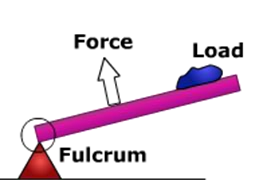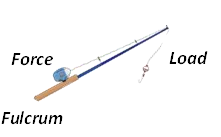Class Three Lever Examples
A lever could be something as simple as a wooden board with a ridge that freely rotates or moves on a pivot. The most common and popular lever can be found in many playgrounds: a see-saw or teeter-totter. They are found everywhere and it is one of the most useful simple machines. There are three classes of levers. The image below is an example of a Class Three Lever, sometimes called a Third Class Lever.
All classes of levers have four basic parts:
- Beam- The lever, a wooden plank or metal bar resting on the fulcrum.
- Fulcrum- the pivot or the turning point.
- Force- the effort or input needed to move the beam and load.
- Load- the item or object being moved or lifted on the plank.

The Class of Lever is determined by the location of the load, fulcrum, and force.
In a Class Three Lever, the Force is between the Load and the Fulcrum. If the Force is closer to the Load, it would be easier to lift and a mechanical advantage. Examples are shovels, fishing rods, human arms and legs, tweezers, and ice tongs.
A fishing rod is an example of a Class Three Lever. The Load of course is the big fish at the end of the line and top of the rod. The Beam is the rod itself, and the Force is the person reeling in the fish using the rod's handle between the two ends. The Fulcrum is the bottom part of the handle of the rod.

However, If the rod was thick enough to hold at the tip closer to where the fish would be, the load would become easier to lift.
An arm is another example of a third class lever. The elbow area is the Fulcrum, the upper arm muscle acts as the force, and the load will be located in the hand, which could be used to lift, push, or grab. A broom is another example of a Class Three Lever. Notice the similar locations of the Fulcrum, Force, and Load.

|
Related Links: Examples Simple Machines Examples |
Human Body Facts for Kids
Science Quizzes
Hibiscus Facts
Gravity Examples
Taj Mahal Facts
Brave New World Chapter 2 Summary
Hypothesis Examples
Simple Machines Quiz
Science Reading Comprehension Topics
